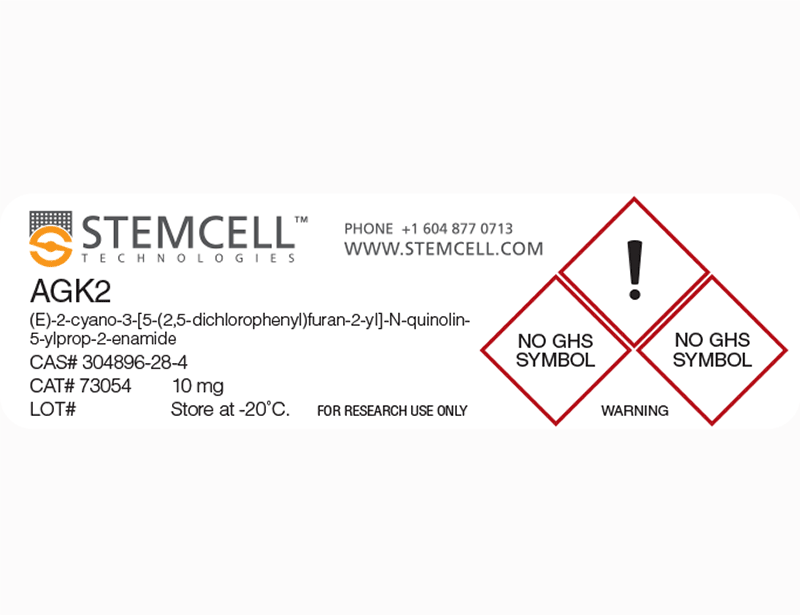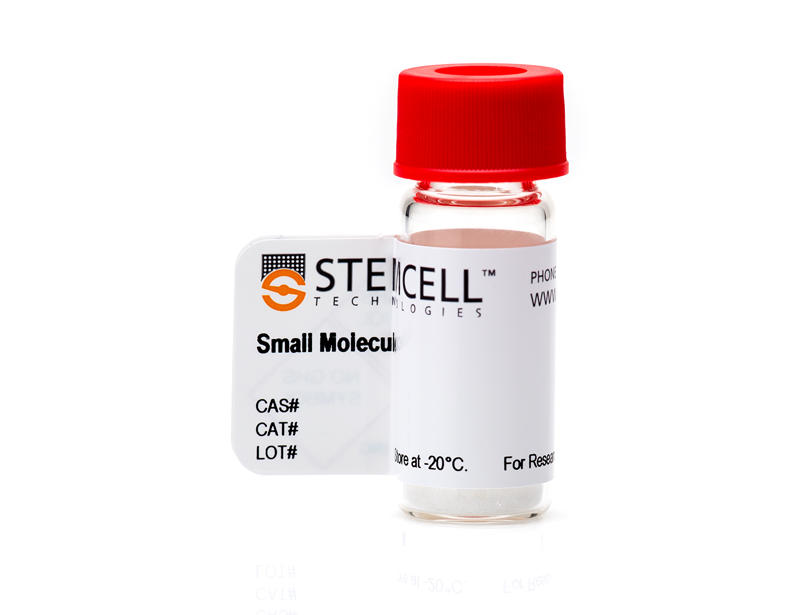概要
AGK2 is a cell-permeable, reversible inhibitor of mammalian sirtuin 2 (SIRT2) activity (IC₅₀ = 3.5 μM). It displays minimal activity against SIRT1 or SIRT3 (IC₅₀ > 50 µM; Outeiro et al.). Its target, SIRT2, is a nicotinamide adenine dinucleotide (NAD)-dependent histone deacetylase (HDAC) with roles in neurodegeneration, aging, cell cycle progression, and tumorigenesis.
IMMUNOLOGY
· Activates the NLRP3 inflammasome in mouse bone marrow-derived macrophages (Youm et al.).
CANCER RESEARCH
· Decreases aldehyde dehydrogenase (ALDH1)+ cancer stem cells in primary breast cancer populations (Zhao et al. 2014).
· Decreases SIRT2-induced autophagy in human cancer cell lines (Zhao et al. 2010).
DISEASE MODELING
· Protects dopaminergic neurons from α-synuclein-mediated toxicity in in vitro and in vivo models of Parkinson's disease (Outeiro et al.).
IMMUNOLOGY
· Activates the NLRP3 inflammasome in mouse bone marrow-derived macrophages (Youm et al.).
CANCER RESEARCH
· Decreases aldehyde dehydrogenase (ALDH1)+ cancer stem cells in primary breast cancer populations (Zhao et al. 2014).
· Decreases SIRT2-induced autophagy in human cancer cell lines (Zhao et al. 2010).
DISEASE MODELING
· Protects dopaminergic neurons from α-synuclein-mediated toxicity in in vitro and in vivo models of Parkinson's disease (Outeiro et al.).
技术资料
| Document Type | 产品名称 | Catalog # | Lot # | 语言 |
|---|---|---|---|---|
| Product Information Sheet | AGK2 | 73052, 73054 | All | English |
| Safety Data Sheet | AGK2 | 73052, 73054 | All | English |
数据及文献
Publications (4)
Nature medicine 2015 MAR
The ketone metabolite β-hydroxybutyrate blocks NLRP3 inflammasome-mediated inflammatory disease.
Abstract
Abstract
The ketone bodies β-hydroxybutyrate (BHB) and acetoacetate (AcAc) support mammalian survival during states of energy deficit by serving as alternative sources of ATP. BHB levels are elevated by starvation, caloric restriction, high-intensity exercise, or the low-carbohydrate ketogenic diet. Prolonged fasting reduces inflammation; however, the impact that ketones and other alternative metabolic fuels produced during energy deficits have on the innate immune response is unknown. We report that BHB, but neither AcAc nor the structurally related short-chain fatty acids butyrate and acetate, suppresses activation of the NLRP3 inflammasome in response to urate crystals, ATP and lipotoxic fatty acids. BHB did not inhibit caspase-1 activation in response to pathogens that activate the NLR family, CARD domain containing 4 (NLRC4) or absent in melanoma 2 (AIM2) inflammasome and did not affect non-canonical caspase-11, inflammasome activation. Mechanistically, BHB inhibits the NLRP3 inflammasome by preventing K(+) efflux and reducing ASC oligomerization and speck formation. The inhibitory effects of BHB on NLRP3 are not dependent on chirality or starvation-regulated mechanisms like AMP-activated protein kinase (AMPK), reactive oxygen species (ROS), autophagy or glycolytic inhibition. BHB blocks the NLRP3 inflammasome without undergoing oxidation in the TCA cycle, and independently of uncoupling protein-2 (UCP2), sirtuin-2 (SIRT2), the G protein-coupled receptor GPR109A or hydrocaboxylic acid receptor 2 (HCAR2). BHB reduces NLRP3 inflammasome-mediated interleukin (IL)-1β and IL-18 production in human monocytes. In vivo, BHB or a ketogenic diet attenuates caspase-1 activation and IL-1β secretion in mouse models of NLRP3-mediated diseases such as Muckle-Wells syndrome, familial cold autoinflammatory syndrome and urate crystal-induced peritonitis. Our findings suggest that the anti-inflammatory effects of caloric restriction or ketogenic diets may be linked to BHB-mediated inhibition of the NLRP3 inflammasome.
The Journal of clinical investigation 2014 DEC
NOTCH-induced aldehyde dehydrogenase 1A1 deacetylation promotes breast cancer stem cells.
Abstract
Abstract
High aldehyde dehydrogenase (ALDH) activity is a marker commonly used to isolate stem cells, particularly breast cancer stem cells (CSCs). Here, we determined that ALDH1A1 activity is inhibited by acetylation of lysine 353 (K353) and that acetyltransferase P300/CBP-associated factor (PCAF) and deacetylase sirtuin 2 (SIRT2) are responsible for regulating the acetylation state of ALDH1A1 K353. Evaluation of breast carcinoma tissues from patients revealed that cells with high ALDH1 activity have low ALDH1A1 acetylation and are capable of self-renewal. Acetylation of ALDH1A1 inhibited both the stem cell population and self-renewal properties in breast cancer. Moreover, NOTCH signaling activated ALDH1A1 through the induction of SIRT2, leading to ALDH1A1 deacetylation and enzymatic activation to promote breast CSCs. In breast cancer xenograft models, replacement of endogenous ALDH1A1 with an acetylation mimetic mutant inhibited tumorigenesis and tumor growth. Together, the results from our study reveal a function and mechanism of ALDH1A1 acetylation in regulating breast CSCs.
Nature cell biology 2010 JUL
Cytosolic FoxO1 is essential for the induction of autophagy and tumour suppressor activity.
Abstract
Abstract
Autophagy is characterized by the sequestration of bulk cytoplasm, including damaged proteins and organelles, and delivery of the cargo to lysosomes for degradation. Although the autophagic pathway is also linked to tumour suppression activity, the mechanism is not yet clear. Here we report that cytosolic FoxO1, a forkhead O family protein, is a mediator of autophagy. Endogenous FoxO1 was required for autophagy in human cancer cell lines in response to oxidative stress or serum starvation, but this process was independent of the transcriptional activity of FoxO1. In response to stress, FoxO1 was acetylated by dissociation from sirtuin-2 (SIRT2), a NAD(+)-dependent histone deacetylase, and the acetylated FoxO1 bound to Atg7, an E1-like protein, to influence the autophagic process leading to cell death. This FoxO1-modulated cell death is associated with tumour suppressor activity in human colon tumours and a xenograft mouse model. Our finding links the anti-neoplastic activity of FoxO1 and the process of autophagy.
Science (New York, N.Y.) 2007 JUL
Sirtuin 2 inhibitors rescue alpha-synuclein-mediated toxicity in models of Parkinson's disease.
Abstract
Abstract
The sirtuins are members of the histone deacetylase family of proteins that participate in a variety of cellular functions and play a role in aging. We identified a potent inhibitor of sirtuin 2 (SIRT2) and found that inhibition of SIRT2 rescued alpha-synuclein toxicity and modified inclusion morphology in a cellular model of Parkinson's disease. Genetic inhibition of SIRT2 via small interfering RNA similarly rescued alpha-synuclein toxicity. Furthermore, the inhibitors protected against dopaminergic cell death both in vitro and in a Drosophila model of Parkinson's disease. The results suggest a link between neurodegeneration and aging.

 网站首页
网站首页





